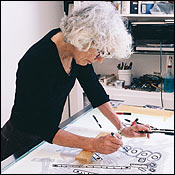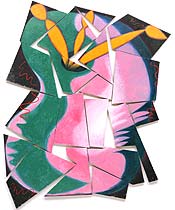
When Mondrian called one of his last paintings Broadway Boogie Woogie, he gave Western culture a serious kick in the pants. Even this austere puritan, it turned out, respected the pizzazz of American culture. Even he could not turn his back upon the staccato street, with its slang and swagger, or ignore the brio of Coney Island, gangsters, and the comics. Most pop culture was trash, but there was also something undeniably romantic, dreamy, and larger-than-life about its jazzy vitality. There was a pop sublime. And if nothing else, pop was a fact of life—the “landscape” of our time. Over the years, many high artists have tapped its energy, trying to create robust hybrids of high and low that can seriously express the full scale of feeling found in earlier art.
With mixed success. Artists who work in this area often come across as condescending intellectuals, slumming wannabes, or poseurs who don’t understand what they’re working with, like opera singers who croon jazz with embarrassing results. Elizabeth Murray, by contrast, seems entirely at home with her subject. Her shaped paintings are sometimes too goofily cute and may repel viewers who don’t have a soft spot for the lip-smacking raucousness of American culture, but they’re also undeniably alive. They’re high-low mutations. Art critters. In an interview with Robert Storr, who organized the retrospective that opened last week at the Museum of Modern Art, Murray, who’s now 65 years old, uses informal phrases like “big bloopy shapes.” (One painting is called Yikes.) But she has a rigorous eye for form, and also deftly analyzes high art. Nothing else looks like her work. She’s sui generis.

Murray’s taste for the outlandish visual character of American pop probably developed early in life. She grew up in a struggling family, one not wired into the art world, and many of her pictures echo the cartoons, illustrations, and graphics of the early and mid–twentieth century. As a young painter, however, she intently studied Cézanne, Picasso, and de Kooning, among others—to see how they did it formally and technically—and responded warmly to the Surrealists, whose twisty organic shapes never looked comfortable inside art’s box. She also became a savvy observer of the contemporary art world of the sixties, seventies, and eighties. Like many in her generation, she took up the Minimalist aesthetic in the seventies, creating a series of ladderlike forms that reflected the fashion for grids—yet her pictures never appeared severe or conceptual in spirit. Instead, they were painted with the tender, animal clumsiness of Philip Guston, another artist who loved cartoons.
Murray’s signature style developed in the early eighties, when her paintings began to crack into eccentrically shaped pieces. In Painter’s Progress, from 1981, she shattered the image of a palette and three brushes—a symbolic escape from the usual boundaries of art. Soon, the pictures began to buckle and bend into something that resembles sculptural relief. She also developed an eye-popping feeling for color that was boisterous and sometimes disagreeable, like the garish color of a pop sign abandoned in a junkyard. At the time, others were also making relieflike pictures, notably Frank Stella, but Murray’s work always seemed much more personal than Stella’s. Her images usually contained recognizable elements, sometimes of a domestic kind, such as tables, spoons, cups, keyholes. (Storr calls these pictures “emphatically unstill lifes.”) Others had a kind of rude sexual humor or evoked bodies and birth; they’re full canals, mouths, little arms, tadpole forms, and alien sci-fi pods. Critics like to emphasize Murray’s gender, finding a woman’s preoccupations in her art. They’re right, of course, but only up to a point: Many men have also painted domestic scenes, and the Surrealists, in particular, loved everything to do with the body’s plumbing.
Murray plays lots of formal tricks in her paintings, working the edges between illusion and reality. Until you look closely, for example, you might not be certain whether a curve is just a line or a bulge into actual space. Formal games of this kind give her pictures visual ambiguity, acting as a foil for their cartoony pow! Her compositional manner does something similar. Despite the writhing forms, the pictures are always carefully balanced—even tidy in the way they hold together. In the grand scheme of things, Murray’s art has both lively historical and social implications. Sometimes, it looks like another “death of painting” response, an effort to revive a fading patient with extreme formal devices and outrageous effects. At others, it seems almost heartwarming. I always think affectionately about American slang when I look at her work. Loosey-goosey. Wacko. Bananas. She also leaves me searching for analogies, particularly about a certain kind of change—that moment, in particular, when something sitting still begins to move. In the old cartoons, rooms would come alive when no one was looking. The chair would begin to lean, the walls to melt, the spoon to bend. Is Murray’s work what painting does behind your back? She has none of the cool irony of early Pop artists, such as Roy Lichtenstein or Andy Warhol. She’s all about warm Pop. She helps viewers embrace the strange, often slangy character of America.
Elizabeth Murray
Museum of Modern Art.
Through
January 9.